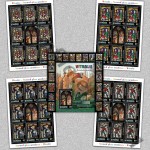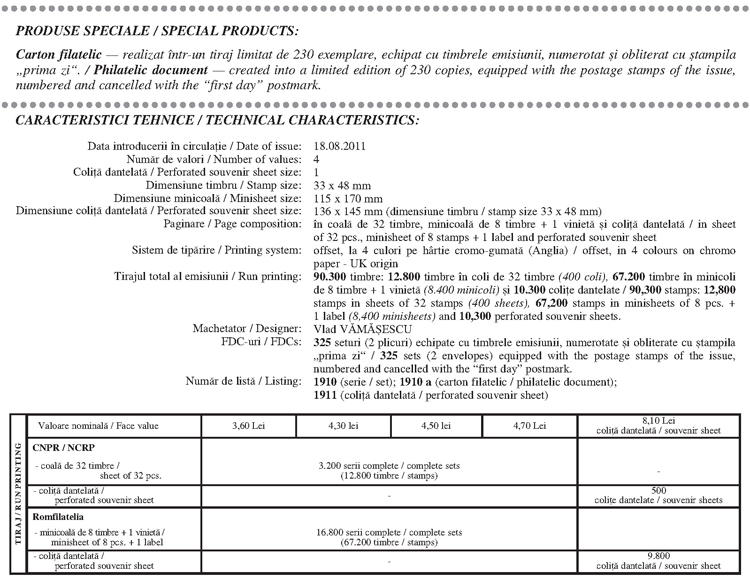 You, traveller… once you enter Bucharest – the Little Paris of the Balkans – you should stay a while near Miorita Fountain and look towards the former Baneasa Royal Railway Station. On the left,you will see a Tudor style building, partially covered by ivy. You should enter “Eng. Dumitru Furnica-Minovici” Western Old Art Museum of the Romanian Academy and you will go back, even just for a moment, in faded past times but full of mystery and… art!You, traveller… once you enter Bucharest – the Little Paris of the Balkans – you should stay a while near Miorita Fountain and look towards the former Baneasa Royal Railway Station. On the left,you will see a Tudor style building, partially covered by ivy. You should enter “Eng. Dumitru Furnica-Minovici” Western Old Art Museum of the Romanian Academy and you will go back, even just for a moment, in faded past times but full of mystery and… art!
You, traveller… once you enter Bucharest – the Little Paris of the Balkans – you should stay a while near Miorita Fountain and look towards the former Baneasa Royal Railway Station. On the left,you will see a Tudor style building, partially covered by ivy. You should enter “Eng. Dumitru Furnica-Minovici” Western Old Art Museum of the Romanian Academy and you will go back, even just for a moment, in faded past times but full of mystery and… art!You, traveller… once you enter Bucharest – the Little Paris of the Balkans – you should stay a while near Miorita Fountain and look towards the former Baneasa Royal Railway Station. On the left,you will see a Tudor style building, partially covered by ivy. You should enter “Eng. Dumitru Furnica-Minovici” Western Old Art Museum of the Romanian Academy and you will go back, even just for a moment, in faded past times but full of mystery and… art!
The house belonged to Dumitru Furnica-Minovici (1897-1982),who designed it from the very beginning as a museum-house, being built between 1941 and 1942.
You, traveller, should step through the Baroque style oak door leading to the hall of the museum. The door is a perfect reproduction of the front one of Hornby Castle of Yorkshire. Above it, you will see a stone bas-relief (St. Hubertus’ coat of arms) which joins to many others, covering the exterior walls of the house.
The hall walls are full of hunting scenes engravings, as well as hunting trophies, many of them hunted in the Austrian forests by Dumitru Furnica-Minovici himself. Next to them, you may see old weapons (15th – 18th centuries): arbalests, halberds, swords, rifles, gauntlets.
And here again, you will find sculptures from the 16th century, reproductions of some famous sculptures from the 15th and 16th centuries.
The main hall of the museum will impress you by its sizes (it is 12 m long and 8 m high), as well as the distinction of the wood ceiling, done in beams and caissons in the Plantagenet style, a style also taken over by the Italian Renaissance.
In this hall you will see a piece of monumental art: the stone sculptured chimney from the 16th century brought from as far as Tuscany, from a village near Florence (Fiesole).
Another piece, impressing not only by its size is the Flemish origin tapestry worked at the manufacture of Jacob van Segers (1600-1640), a Brussels man, whose family is mentioned for the first time as owner of a tapestry manufacture, in Brussels, around 1442.
Both, on the right and left sides of the chimney and tapestry,there are paintings signed by important Italian, German, Dutch, Flemish painters.
Just like in the main hall, in the rest of the rooms you may see besides paintings, also art furniture objects – hope chests, English and Dutch tables, French and English chairs and also the Austrian massive walnut wood bookcase. Certainly, in all rooms you may admire Renaissance and Gothic paintings from important Western old art centers.
But what makes this museum different from others in Romania is the variety of stained glass windows.
These were made between the 15th and 19th centuries and even if they are German, Swiss or Austrian, they all represent various biblical scenes, coat of arms of some towns or families, war scenes, allegories.
Through the beauty and accuracy of colours, they let the sunlight enrich every room in any time of the day, giving a special value to each wall of the museum.
And now, after… a moment of spirituality you, traveller, may go farther on your way towards the eventful town, but you should not forget you have just left an art sanctuary.
Wishing to promote the cultural and art institutions, as well as the values of the national patrimony, Romfilatelia introduces into circulation the postage stamps issue entitled Stained glass windows – “Eng. Dumitru Furnica-Minovici“ Western Old Art Museum.
On the postage stamp with the face value of 3.60 lei is illustrated The Artist, an Austrian stained glass window from the 18th century.
On the postage stamp with the face value of 4.30 lei is illustrated St. Katharina, an Austrian stained glass window made in 1888 by Gerard van Treeck.
On the postage stamp with the face value of 4.50 lei is illustrated the Austrian stained glass window entitled Hunter (Tyrolese), made in 19th century by Gerard van Treeck.
On the postage stamp with the face value of 4.70 lei is illustrated The lady in green, a German stained glass window from the 17th-18th century.
On the postage stamp of the souvenir sheet of the issue with the face value of 8.10 lei are illustrated stained glass windows made in North Tyrol, on the left side St. Hieronimus, and on the right Lazar Resurrection (they both were supposedly made at the end of the 15th century or at the beginning of the 16th century).
We kindly thank the Romanian Academy and “Eng. Dumitru Furnica-Minovici” Western Old Art Museum (belonging to the Romanian Academy patrimony) for the documentary assistance granted in the accomplishment of this postage stamps issue.
Issue date: 2011-08-18



